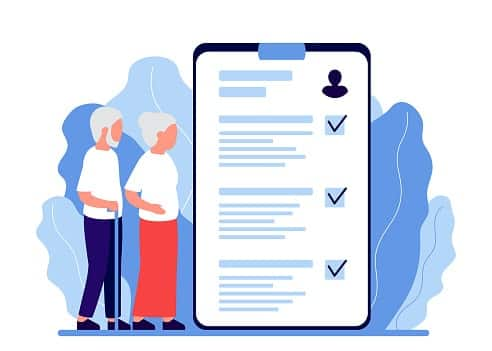- What is the Medicare Annual Enrollment Period (AEP)?
- When is Medicare Annual Enrollment Period?
- Parts of Original Medicare
- How to change Medicare plans
- Medicare costs
- How to qualify for a Medicare Special Enrollment Period (SEP)
- How to enroll in Medicare
- Part A, Part B, Part C and Part D costs
- When else can you change Medicare plans?
- What should you do during Medicare Annual Enrollment Period?
- Tips to get ready for the Medicare Annual Enrollment Period (AEP)
- Frequently asked questions
What is the Medicare Annual Enrollment Period (AEP)?
Medicare Annual Enrollment Period runs from October 15 and through December 7 each year. This is the time for eligible beneficiaries to make a change to their Medicare health plan and prescription drug coverage. These changes will go into effect on January 1 of the following year and will carry forward throughout that year.
Medicare beneficiaries don’t have to do anything during open enrollment if their current plan is being offered again and they’re satisfied with their coverage. Instead, coverage will automatically carry over into the next year.
That said, it’s still a good idea to see what other options are now available. Health insurance companies expand their Medicare Advantage options each year, so you may find a better plan for you this year.
When is Medicare Annual Enrollment Period?
For most people on Medicare, the term "open enrollment" refers to the period between October 15 and December 7, and is actually known as AEP, or Medicare Annual Enrollment Period. This is the time each fall when those enrolled in Medicare plans may opt to change their coverage for the following year.
However, other enrollment periods apply to some people. For example, if you have never signed up for Medicare before, you have an initial Medicare enrollment period that starts three months before the month you turn 65 and ends three months after the month you turn 65. You may also be eligible for enrolling in Medicare before you turn 65 if you have a qualifying condition such as end-stage renal disease or ALS.
People with Medicare Advantage can also change plans during the more limited Medicare Advantage Open Enrollment from January 1 to March 31. People can only switch Medicare Advantage plans or move from Medicare Advantage to Original Medicare during that time and only one change is allowed.
| Open enrollment | What is it? | When is it? |
|---|---|---|
| Initial Enrollment Period | When you first become eligible for Medicare at the age of 65 (or if you have a qualifying disability qualifying you for enrollment before you turn 65) | From three months before your 65th birthday month to three months after your 65th birthday month |
| Medicare Annual Enrollment Period | Annual period when you can make changes to your Medicare coverage | October 15 to December 7 |
| Medicare Advantage Open Enrollment Period | Annual period when those with a Medicare Advantage Plan can either change Medicare Advantage plans or move to Original Medicare. Only one change can be made during this period. | January 1 to March 31 |
| Special Enrollment Period (SEP) | Special period when you can make changes to your Medicare coverage if you have a qualifying life event | Varies |
Parts of Original Medicare
Let’s quickly review the types of Medicare:
- Part A -- Inpatient hospital care
- Part B -- Physician services, outpatient care, lab work, X-rays and preventive services, among others
- Part C (Medicare Advantage) -- Medicare plans offered by private insurers; coverage includes inpatient, physician and often prescription drug coverage and supplemental benefits, such as vision and dental
- Part D (prescription drugs) -- Prescription drug coverage for people with Parts A and/or B who have opted-in for this coverage
Parts A and B are often called Original Medicare. If you have Original Medicare, you can pair it with Part D for prescription drug benefits. Since most Medicare Advantage plans include prescription drug coverage, those with a Medicare Advantage plan usually cannot purchase a standalone Part D plan.
The federal government offers Original Medicare. Private insurers provide Medicare Advantage plans.
How to change Medicare plans
If you’re enrolled in a Medicare Advantage plan and want to switch to a new plan, you can simply search for a plan and change to it during an enrollment period.
If you have Original Medicare and want to switch to a Medicare Advantage plan, you can also do so during AEP. Just remember that Medicare Advantage plans typically have a prescription drug component. That means if you signed up for Medicare Part D to cover your medications, you may no longer need that coverage. Enrollment in a Medicare Advantage plan will automatically disenroll the consumer from a Part D or previous Medicare Advantage plan. Medicare supplements require the consumer to call and cancel if an enrollment in a Medicare Advantage plan occurs.
Starting January 1, 2025, if you sign up for Part A and/or Part B because of an exceptional situation, you’ll have 2 months to join a Medicare Advantage Plan (with or without drug coverage) or a Medicare drug plan (Part D). Your coverage will start the first day of the month after the plan gets your request to join.
Medicare costs
Each year, Medicare and Medicare Advantage plans make changes to plans and offerings. Here’s what changed in 2025:
Original Medicare changes
Part B premiums for 2025 are $185.00 for individuals earning $103,000 or less and couples earning $206,000 or less. Also, Part B premiums are higher for people with incomes above $103,000 for individuals and above $206,000 for married joint filers. The Part B deductible in 2025 is $257.
Original Medicare often has higher premiums than Medicare Advantage plans.
People with Original Medicare also can enroll in a Part D prescription drug benefit plan.
Medicare Advantage changes
Some 32.8 million people were enrolled in Medicare Advantage plans in 2024, according to the KFF, formerly known as the Kaiser Family Foundation. In addition, in 2024, there were more than 6.6 million Medicare beneficiaries enrolled in SNPs (Special Needs Plans).
Between 2023 and 2024, there was a 16% increase in enrollment in SNPs. Special Needs Plans, “restrict enrollment to specific types of beneficiaries with significant or relatively specialized care needs, or who qualify because they are eligible for both Medicare and Medicaid,” according to KFF.
Several top health insurers are also expanding into hundreds of new counties nationwide in 2024. On average, a person who is eligible for Medicare may be able to choose Medicare Advantage plans from eight firms.
How to qualify for a Medicare Special Enrollment Period (SEP)
There are times in life when you may qualify for a Special Enrollment Period for both Medicare Advantage and Medicare Part D. A special enrollment period allows you to make changes to your Medicare coverage outside of open enrollment.
You may qualify for such a period if you:
- Change where you live. Perhaps the new plan isn't available in your new community or you move back to the U.S. after living abroad.
- Lose your current coverage. Maybe you lose eligibility for Medicaid coverage or are no longer covered by an employer.
- Have a chance to get other coverage. Perhaps you now can enroll in drug coverage that is just as good as what Medicare offers, such as TRICARE or VA coverage.
- Have a plan that changes its contract with Medicare. The government may sanction your plan for some transgression on the part of the plan or Medicare might not renew a contract with a plan.
There are other situations where you might qualify for a special enrollment period, which are detailed on the official Medicare website.
How to enroll in Medicare
If you receive Social Security benefits for at least four months before turning 65, you’re automatically enrolled in Medicare Part A when you become eligible for coverage at 65.
In addition, you’re enrolled in Medicare Part B, but it’s your decision as to whether or not to keep this part of your Medicare coverage. You can decide to delay signing up for Part B (and face potentially premium penalties when you later get Part B) or you can also choose a Medicare Advantage plan.
You also can enroll in Medicare by going to the Social Security website or calling Social Security at 1-800-772-1213. TTY users can call 1-800-325-0778. If you prefer, stop by your local Social Security office and sign up that way.
If you or your spouse worked for a railroad, you can enroll in Medicare by calling the Railroad Retirement Board at 1-877-772-5772.
If you have a qualifying condition such as end-stage renal disease or ALS, you may qualify for Medicare before you turn 65.
Part A, Part B, Part C and Part D costs
Premiums and out-of-pocket costs are vital when comparing Medicare plans. Here are the average premiums for Parts A-D:
Part A - Medicare Part A is usually free as long as you’ve been employed and paid the Medicare tax for at least 10 years. The 2025 Part A premium for those who aren't eligible for premium-free coverage is either $278 or $505 each month for Part A, depending on how long your or your spouse worked and paid Medicare taxes. Part A’s deductible in 2025 is $1,632 for each benefit period, which is when you’re admitted to a hospital.
Part B - The Part B monthly premium for 2025 is $185.00 for individuals earning $103,000 or less and for couples earning $206,000 or less. Those with higher incomes pay higher monthly premiums. The deductible has been increased from $257 for 2025. Once you meet that deductible, you pay 20% of your Part B health care costs.
Part C (Medicare Advantage) - Medicare Advantage premiums vary by plan.
Part D (drug plan) - Similar to Medicare Advantage, Part D premiums and deductibles vary.
When else can you change Medicare plans?
Medicare Annual Enrollment Period isn’t the only time you can switch Medicare plans. Other times are when you’re newly eligible or have experienced a life event that triggers a special enrollment period.
When you’re first eligible for Medicare, you have a seven-month span to sign up for coverage. That includes the three months before your qualifying birthday, your birth month and the three months after that birth month.
However, once you have a plan, according to CMS, you can trigger a special enrollment period if:
You change where you live and
- The new address is not in your plan’s service area
- The plan is still in the service area, but there are new options in the new location
- You moved back to the U.S. after living outside of the country
- You just moved into, currently live in, or just moved out of an institution
- You are released from jail
- You move to another state
You lose your current coverage and
- You are no longer eligible for Medicaid
- You left coverage from your employer or union (including COBRA coverage)
- You involuntarily lose coverage that’s as good as Medicare drug coverage (creditable coverage), or your other coverage changed and is no longer credible
- You had drug coverage through a Medicare Cost Plan and you leave the plan
- You dropped your coverage in a Program of All-inclusive Care for the Elderly (PACE) plan
Your plan changes its contract with Medicare
- Medicare ends your plan’s contract
- Your Medicare Advantage Plan, Medicare Prescription Drug Plan, or Medicare Cost Plan’s contract with Medicare isn’t renewed
- Other special situations occur (see the CMS website for details)
- If those life events happen to you, you can contact Medicare about kicking off a special enrollment period. In that case, you’ll be able to make changes to your Medicare coverage or sign up for a new plan.
What should you do during Medicare Annual Enrollment Period?
Medicare Annual Enrollment Period, often referred to as AEP, or sometimes called "Medicare open enrollment," is a great time to review your plan and figure out what you want from a health plan.
What to think about during Medicare during Medicare Annual Enrollment Period each fall:
- Have your plan needs changed?
- Do you have a chronic illness that a Medicare Advantage plan targets?
- Are you paying higher premiums than you need?
- Is your plan’s deductible too high?
- Is there a new plan offering that makes more sense for your situation?
- Is there a better Part D drug plan? Does that Part D plan cover your mediations?
- If you find a better plan, does your doctor and hospital accept it?
Visit Medicare.gov to get information about plans in your area or call 1-800-MEDICARE. You can also go to the Medicare Plan Finder to compare plans available for you.
Tips to get ready for the Medicare Annual Enrollment Period (AEP)
As you prepare for AEP, consider your health care needs over the past year, and anticipate what your needs might be in 2025.
“Prepare yourself in advance with a list of services you use the most, doctors and hospitals that are important to you and any prescriptions that you take,” says Lisa Wright, principal consultant for community programs at BlueCross BlueShield of Tennessee.
If you’re thinking about enrolling in Medicare Advantage or finding a new plan, you should weigh three major factors before choosing a plan, Wright says.
- Costs. Consider extra charges, such as copayments or coinsurance, and the cost of prescription medications. "It’s important to not only consider the monthly premium but also any other costs you might experience," Wright says.
- A plan's coverage network. Make sure all your health care providers are included in the network. "Don’t forget to check your pharmacy to ensure it’s in the network," Wright says.
- Any other extras. Many Medicare Advantage plans offer additional perks, such as dental, vision and/or hearing benefits.
Check out the website of any insurer you are considering and look over the pharmacy network and provider network. Then, compare benefit designs.
Wright notes that BlueCross BlueShield of Tennessee offers education to Medicare recipients via in-person community meetings and enrollment events, as well as virtual meetings and educational sessions. Other carriers offer similar help.
Health insurance finder tool

COBRA
Learn more about COBRA
How much is your annual household income?
How many members are in your household?
Medicare
Medicare costs vary depending on which option you choose.
Learn more about Medicare costs.
Medicaid

Parent's employer-sponsored health insurance

Spouse's employer-sponsored health insurance

Employer-sponsored health insurance

Preferred-provider Organization (PPOs)
Preferred-provider organization (PPOs) plans are the most common type of
employer-based health plan. PPOs have higher premiums than HMOs and HDHPs, but
those added costs offer you flexibility. A PPO allows you to get care anywhere
and without primary care provider referrals. You may have to pay more to get
out-of-network care, but a PPO will pick up a portion of the costs.
Find out more about the differences between plansHealth maintenance organization (HMO)
Health maintenance organization (HMO) plans have lower premiums than PPOs.
However, HMOs have more restrictions. HMOs don't allow you to get care outside
of your provider network. If you get out-of-network care, you'll likely have to
pay for all of it. HMOs also require you to get primary care provider referrals
to see specialists.
Find out more about the differences between plansHigh-deductible health plans (HDHPs)
High-deductible health plans (HDHPs) have become more common as employers look
to reduce their health costs. HDHPs have lower premiums than PPOs and HMOs, but
much higher deductibles. A deductible is what you have to pay for health care
services before your health plan chips in money. Once you reach your deductible,
the health plan pays a portion and you pay your share, which is called
coinsurance.
Find out more about the differences between plansExclusive provider organization (EPO)
Exclusive provider organization (EPO) plans offer the flexibility of a PPO with
the restricted network found in an HMO. EPOs don't require that members get a
referral to see a specialist. In that way, it's similar to a PPO. However, an
EPO requires in-network care, which is like an HMO.
Find out more about the differences between plans
Learn more about individual insurance plans
Medicare Advantage and Part D plans and benefits offered by the following carriers: Aetna Medicare, Anthem Blue Cross and Blue Shield, Aspire Health Plan, Baylor Scott & White Health Plan, Capital Blue Cross, Cigna Healthcare, Dean Health Plan, Devoted Health, Florida Blue Medicare, GlobalHealth, Health Care Service Corporation, Healthy Blue, Humana, Molina Healthcare, Mutual of Omaha, Medica Central Health Plan, Premera Blue Cross, Priority Health, SCAN Health Plan, Simply, UnitedHealthcare, Wellcare, WellPoint.
Sources:
- Medicare.gov. “Costs.” Accessed May 2025.
- KFF. “Medicare Advantage 2025 Spotlight: A First Look at Plan Offerings.” Accessed May 2025.
- KFF. “Medicare Advantage in 2024: Enrollment Update and Key Trends.” Accessed May 2025.
Disclaimer:
Insurance.com is not affiliated with or endorsed by the government or Federal Medicare program. Plans are insured or covered by a Medicare Advantage organization with a Medicare contract and/or a Medicare approved Part D sponsor. Enrollment in the plan depends on the plan’s contract renewal with Medicare. We do not offer every plan available in your area. Currently we represent 23 organizations which offer 52,180 products in your area. Please contact Medicare.gov, 1800-MEDICARE, or your local State Health Insurance Program (SHIP) to get information on all of your options. Not all plans offer all of these benefits. Benefits and availability may vary by carrier and location. Limitations and exclusions may apply. Deductibles, copays and coinsurance may apply. Enrollment in the described plan type may be limited to certain times of the year unless you qualify for a Special Enrollment Period.
MULTIPLAN_ICOMMEDOE0126_C
Frequently asked questions
When can people get information about next year’s Medicare plans?
Typically, information about the following year's plans is available in October, according to the U.S. Centers for Medicare & Medicaid Services. In recent years, some information about the following year's costs has been available in late September, while final costs are released in early November.
Where can people find Medicare plan information or compare plans?
The best place to look for Medicare plan information is the U.S. Centers for Medicare & Medicaid Services website. There, you will find information about both Original Medicare and Medicare Advantage coverage.
CMS has a webpage with a tool allowing you to compare Medicare Advantage plans and Medicare Part D prescription drug coverage.
CMS also has published a PDF that lets you compare and contrast the basic features of the five major types of Medicare Advantage plans. Finally, if you need a Medigap policy, CMS offers detailed information about this coverage on its website.
When can you sign up for Medicare supplement plans?
The federal government urges people to buy a Medicare supplement policy, or Medigap, during their six-month Medicare Supplement Open Enrollment Period if they’re interested in Medigap.
During this period – which begins the first month you have Medicare Part B and you are 65 or older – you’re guaranteed coverage, even if you have health issues. You also can get coverage at the most favorable rates.
Once your personal open enrollment period closes, you may be denied for a policy due to poor health or end up paying more for coverage.
However, you might be able to sign up for Medicare supplement insurance if you are eligible under a specific circumstance or guaranteed issue rights. Medicare outlines these situations on its website.
What happens if I miss the Medicare Annual Enrollment Period for?
Those who have Medicare and miss the Medicare Annual Enrollment Period will have to wait until their next open enrollment period to make changes, unless they have a qualifying life event that grants them a Special Enrollment Period.
If I enroll during the Medicare Advantage Annual Enrollment Period, when will my policy begin?
Medicare Advantage Annual Enrollment period runs from January 1 to March 31.
If you make a change to your coverage during that time, the new coverage starts on the first day of the following month.
When can I discontinue a Medicare Advantage plan?
You can disenroll from a Medicare Advantage plan during the Annual Enrollment Period, during the Medicare Advantage Open Enrollment Period, or with a Special Election Period. Call the health insurance company and inform them of when you want to end coverage.












